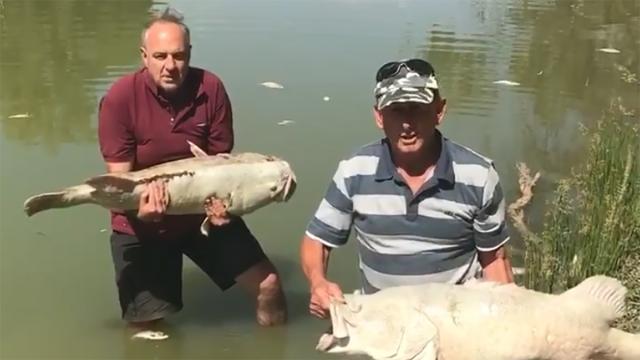We’re only two weeks into the new year, and already an estimated one million fish from NSW’s Murray-Darling basin have perished in mass die-offs. These die-offs have severely depleted the river network’s stock of fish, and unfortunately don’t appear to be stopping any time soon.
However, in as bright a spot as you’re likely to get when talking about mass fish deaths, initial reports of 1800 fish dead at Lake Hume on the NSW-Victoria border have now been revised down to 60.
The NSW Primary Industries Minister Niall Blair revealed earlier today that more fish have died in Lake Hume.
Pictured below are some of those dead carp on the banks of the Hume, there are reports of close to 100 dead fish.
Further details at 6pm.#WINNews6pm pic.twitter.com/yydXgSOBHA
— WIN News Albury (@WINNews_Alb) January 15, 2019
Earlier today, NSW Primary Industries Minister Niall Blair revealed a mass fish die-off at Lake Hume, with reports claiming 1800 carp were killed. Blair also revealed that two other die-offs had occurred at Port Macquarie and Lake Burrendong near Dubbo since Friday, though the type and number of fish is still unknown.
Fortunately, an investigation by the Department of Primary Industries has since revised number of dead fish at Lake Hume down to 60 – a number that could potentially be attributed to fishing. Carp are also considered a pest in Australia, so their deaths aren’t as tragic as it first appeared.
The Lake Hume fish drew significant attention due to other fish deaths that have occurred recently in the Murray-Darling basin. Native fish such as Murray cod and perch are dying in massive numbers, filling rivers with floating bodies. What’s to blame for these disasters depends upon who you ask.
Algae And Drought, Politicians And Farmers, Or All Of The Above?
this video of former Greens MP Jeremy Buckingham throwing up while holding a dead Murray cod is really something pic.twitter.com/hKvK1wv0AE
— Tom Rabe (@Rabe9) January 9, 2019
Last week, a mass die-off killed up to one million fish along the Darling River at Menindee, an event the NSW Department of Primary Industries attributed to blue green algae.
Blue green algae multiplies quickly in warm weather and stagnant water, which the Murray-Darling has had in abundance due to the summer weather and the drought. However, when the temperature drops the algae dies, and when it breaks down it is eaten by bacteria that use oxygen in the water. A lot of algae blooms dying means a lot of bacteria consuming the water’s oxygen, leaving less oxygen for fish to breathe. This can cause fish to suffocate and die in large numbers.
However, some locals are unsatisfied with this explanation, blaming the deaths on the Murray-Darling Basement Authority mismanaging the river network.
At the time of last week’s die-off, a video of Menindee residents Dick Arnold and Rob McCribe went viral. In the minute and a half clip posted to Tolarno Station’s Facebook page, the men stand knee-deep in the Darling River and cradle two large, dead Murray cod, as many more fish float behind them. Though it is unlikely the fish they are holding are 100 years old as they state, that this die-off is an environmental disaster is undeniable.
“This is nothing to do with drought. This is a man-made disaster,” the men claim, pointing the finger at politicians and cotton-growers.
The community in Menindee blames the fish die-offs on a lack of water in the Murray-Darling system, caused by cotton growers using a significant amount of it on their farms.
We are saddened by the scenes of devastation on the Darling River at Menindee. This has had a profound impact on the Barkandji community & all Aboriginal people along the river. Here is a statement from our Chair Cr Roy Ah-See @RoyAhSee #MurrayDarling https://t.co/hQ95eSNp9n pic.twitter.com/i9SaRcw39d
— NSWALC (@nswalc) January 11, 2019
Cotton Australia has denied that cotton farming is to blame. However, The Guardian reports that farming is likely a contributing factor to the massive die-offs.
“Droughts would have contributed to the blue green algae outbreak,” said Richard Kingsford, Director of the Centre for Ecosystem Science at the University of NSW, speaking to The Guardian. “But the river droughts are happening more often and they’re more intense as a result of the irrigation industry in the Darling diverting water from the river over the last 10 to 20 years.”
According to the Parliamentary Library, the majority of the water used from the Murray-Darling basin is employed in agriculture. In 2005-2006, cotton farming accounted for 20 per cent of that amount.
that’s the way it’s gonna be murray darling
full of a million fish corpses yeah yeah— jeremy poxon (@JeremyPoxon) January 10, 2019
MP Niall Blair has announced that the NSW government has purchased 16 solar-powered aerators, which are expected to arrive within the next day. They will be used to help oxygenate the Murray-Darling’s waters, including at Lake Burrendong and the Darling River at Menindee, in the hopes of minimising further die-offs. But Blair admits that this is just a stop-gap measure.
“Nothing will stop this fish kill unless we get proper river flows and water levels in our dams back up to normal, but we’re looking at doing everything we can to try and limit the damage.”
